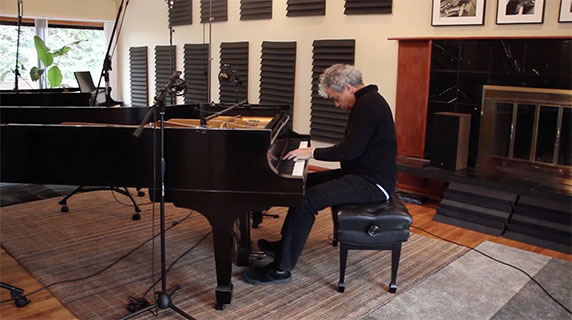
Jovino Santos Neto
Three-time Latin Grammy nominee Jovino Santos Neto, a master pianist, composer and arranger, is among the top Brazilian musicians working today.
Live Seminar Resources
Live Seminar Resources
PDF Downloads
- Alone Together - Chord Chart
Join PianoGroove Pro to access all downloads and learning resources.
Download theory supplements, midi files, chord changes and full note-for-note transcriptions of every lesson.
- Manhã de Carnaval
Join PianoGroove Pro to access all downloads and learning resources.
Download theory supplements, midi files, chord changes and full note-for-note transcriptions of every lesson.
Seminar Description
Seminar Description
Minor 2-5-1 Progressions & Substitutions
Welcome to this lesson on minor 2-5-1 progressions, an essential concept in jazz harmony. In this session, we explore the movement of these cadences, their harmonic function, and how to apply them in different musical contexts.
By the end of this lesson, you will have a deep understanding of minor 2-5-1s, be able to identify them in jazz standards, and learn how to introduce variations through tritone substitutions and altered chord voicings.
Understanding Minor 2-5-1 Cadences
A cadence is a harmonic movement that creates a sense of resolution. The term comes from the Latin word "cadere," meaning "to fall," which reflects how harmonies naturally resolve, much like gravity pulling objects downward.
In jazz, the minor 2-5-1 progression is one of the most common cadences, consisting of:
- II-7b5 (Half-diminished chord)
- V7alt (Dominant chord with alterations)
- I-7 (Minor 7th chord)
For example, in the key of D minor, the progression would be:
- E-7b5 (E half-diminished: E-G-Bb-D)
- A7alt (A dominant 7 with alterations, such as A-C#-E-G-Bb)
- D-7 (D minor 7: D-F-A-C)
This movement creates a strong sense of pull and resolution, commonly found in jazz ballads, swing tunes, and bossa nova.
Chord Voicings & Variations
When voicing minor 2-5-1s, we can use different textures:
- Simple Shell Voicings – Root-3rd-7th formations in the left hand for clarity.
- Spread Voicings – Distributing chord tones between both hands to create a fuller sound.
- Altered Dominants – Introducing b9, #9, or b13 for added tension and color.
- Tritone Substitutions – Replacing the dominant chord with another chord a tritone away.
For example:
- Instead of A7alt in D minor, we could play Eb7alt, which shares common tones and provides a smooth voice-leading option.
Applying Minor 2-5-1s in Jazz Standards
Many jazz standards make extensive use of minor 2-5-1s. In this lesson, we explored:
- "Alone Together" – A classic standard that features minor 2-5-1s in multiple keys.
- "Manhã de Carnaval" (A Day in the Life of a Fool) – A Brazilian bossa nova piece rich in minor 2-5-1 movements.
By studying these tunes, we can see how minor cadences create a flowing harmonic structure and provide opportunities for expressive improvisation.
Developing Intuition for Minor 2-5-1s
Instead of memorizing shapes, focus on developing a deep listening approach. The minor 2-5-1 progression is something you’ve likely heard countless times in jazz and pop music. The goal is to recognize these sounds and anticipate their movement naturally.
One effective exercise is to play minor 2-5-1s in different keys while using the associated scale to improvise simple melodies over them.
For example:
- Play E-7b5 to A7alt to D-7
- Improvise using the D harmonic minor scale (D-E-F-G-A-Bb-C#-D)
This will help you internalize the sound and feel of minor cadences.
5 Practice Tips for Mastering Minor 2-5-1s
- Learn the Progression in All Keys – Cycle through minor 2-5-1s using the circle of fourths to gain fluency.
- Experiment with Voicings – Try rootless voicings, drop-2, and spread voicings for variety.
- Use Alterations on the Dominant – Practice playing V7 chords with b9, #9, or b13 to add harmonic tension.
- Apply Tritone Substitutions – Swap the V7 for its tritone substitute (e.g., A7 → Eb7) to create new harmonic possibilities.
- Listen to Jazz Recordings – Study how pianists like Bill Evans, Herbie Hancock, and Chick Corea approach minor 2-5-1s in their playing.
By consistently practicing and applying these concepts in real musical contexts, you will build a strong harmonic foundation and gain confidence in improvising over minor 2-5-1 progressions.








Jovino,
Terrific seminar! I was not able to attend live, but I will keep coming back to
this time and again. I have been working on Cole Porter’s What Is This Thing
Called Love which propelled me into a deep dive into minor 251’s and exploring
all the possibilities which I see are endless. Many thanks, Becky